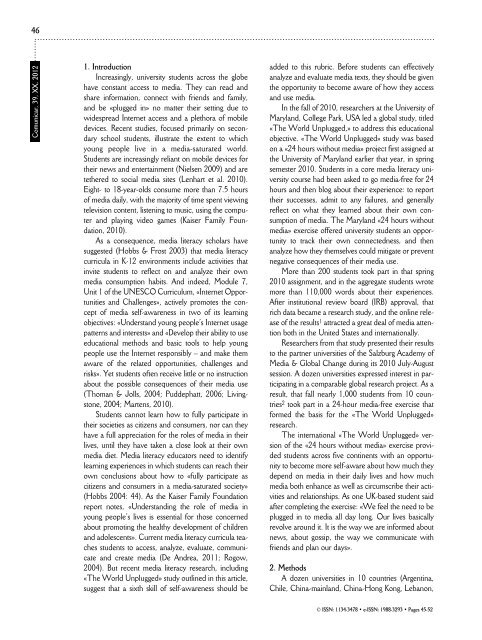Comunicar 39-ingles - Revista Comunicar
Comunicar 39-ingles - Revista Comunicar
Comunicar 39-ingles - Revista Comunicar
You also want an ePaper? Increase the reach of your titles
YUMPU automatically turns print PDFs into web optimized ePapers that Google loves.
46<strong>Comunicar</strong>, <strong>39</strong>, XX, 20121. IntroductionIncreasingly, university students across the globehave constant access to media. They can read andshare information, connect with friends and family,and be «plugged in» no matter their setting due towidespread Internet access and a plethora of mobiledevices. Recent studies, focused primarily on secondaryschool students, illustrate the extent to whichyoung people live in a media-saturated world.Students are increasingly reliant on mobile devices fortheir news and entertainment (Nielsen 2009) and aretethered to social media sites (Lenhart et al. 2010).Eight- to 18-year-olds consume more than 7.5 hoursof media daily, with the majority of time spent viewingtelevision content, listening to music, using the computerand playing video games (Kaiser Family Foun -dation, 2010).As a consequence, media literacy scholars havesuggested (Hobbs & Frost 2003) that media literacycurricula in K-12 environments include activities thatinvite students to reflect on and analyze their ownmedia consumption habits. And indeed, Module 7,Unit 1 of the UNESCO Curriculum, «Internet Oppor -tunities and Challenges», actively promotes the conceptof media self-awareness in two of its learningobjectives: «Understand young people’s Internet usagepatterns and interests» and «Develop their ability to useeducational methods and basic tools to help youngpeople use the Internet responsibly – and make themaware of the related opportunities, challenges andrisks». Yet students often receive little or no instructionabout the possible consequences of their media use(Thoman & Jolls, 2004; Puddephatt, 2006; Living -stone, 2004; Martens, 2010).Students cannot learn how to fully participate intheir societies as citizens and consumers, nor can theyhave a full appreciation for the roles of media in theirlives, until they have taken a close look at their ownmedia diet. Media literacy educators need to identifylearning experiences in which students can reach theirown conclusions about how to «fully participate ascitizens and consumers in a media-saturated society»(Hobbs 2004: 44). As the Kaiser Family Foundationreport notes, «Understanding the role of media inyoung people’s lives is essential for those concernedabout promoting the healthy development of childrenand adolescents». Current media literacy curricula teachesstudents to access, analyze, evaluate, communicateand create media (De Andrea, 2011; Rogow,2004). But recent media literacy research, including«The World Unplugged» study outlined in this article,suggest that a sixth skill of self-awareness should beadded to this rubric. Before students can effectivelyanalyze and evaluate media texts, they should be giventhe opportunity to become aware of how they accessand use media.In the fall of 2010, researchers at the University ofMaryland, College Park, USA led a global study, titled«The World Unplugged,» to address this educationalobjective. «The World Unplugged» study was basedon a «24 hours without media» project first assigned atthe University of Maryland earlier that year, in springsemester 2010. Students in a core media literacy universitycourse had been asked to go media-free for 24hours and then blog about their experience: to reporttheir successes, admit to any failures, and generallyreflect on what they learned about their own consumptionof media. The Maryland «24 hours withoutmedia» exercise offered university students an opportunityto track their own connectedness, and thenanalyze how they themselves could mitigate or preventnegative consequences of their media use.More than 200 students took part in that spring2010 assignment, and in the aggregate students wrotemore than 110,000 words about their experiences.After institutional review board (IRB) approval, thatrich data became a research study, and the online releaseof the results 1 attracted a great deal of media attentionboth in the United States and internationally.Researchers from that study presented their resultsto the partner universities of the Salzburg Academy ofMedia & Global Change during its 2010 July-Augustsession. A dozen universities expressed interest in participatingin a comparable global research project. As aresult, that fall nearly 1,000 students from 10 countries2 took part in a 24-hour media-free exercise thatformed the basis for the «The World Unplugged»research.The international «The World Unplugged» versionof the «24 hours without media» exercise providedstudents across five continents with an opportunityto become more self-aware about how much theydepend on media in their daily lives and how muchmedia both enhance as well as circumscribe their activitiesand relationships. As one UK-based student saidafter completing the exercise: «We feel the need to beplugged in to media all day long. Our lives basicallyrevolve around it. It is the way we are informed aboutnews, about gossip, the way we communicate withfriends and plan our days».2. MethodsA dozen universities in 10 countries (Argentina,Chile, China-mainland, China-Hong Kong, Lebanon,© ISSN: 1134-3478 • e-ISSN: 1988-3293 • Pages 45-52
















